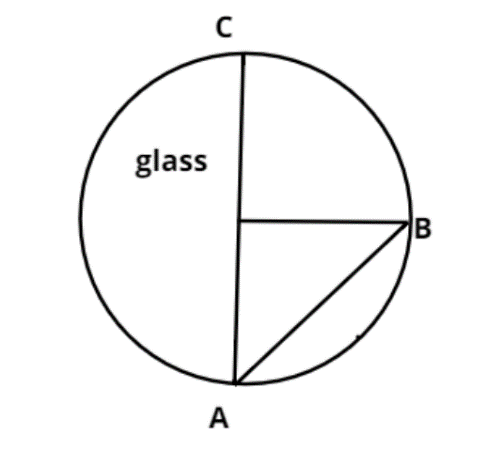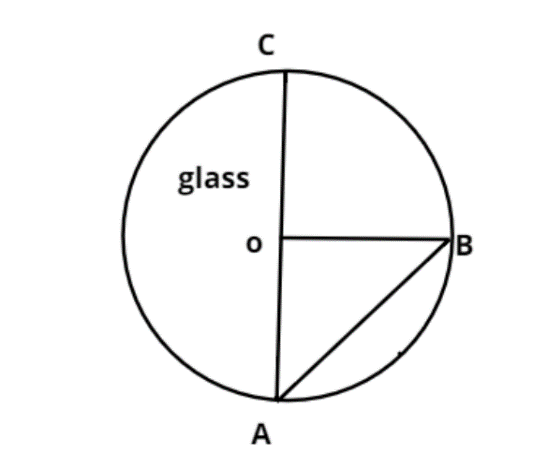Question
Question: It is found that all electro-magnetic signals sent from A towards B reach point C inside the glass s...
It is found that all electro-magnetic signals sent from A towards B reach point C inside the glass sphere, as shown in fig. The speed of the electromagnetic signals in glass cannot be

(a) 1.0×108ms−1 (b) 2.4×108ms−1 (c) 2×107ms−1 (d) 4×107ms−1
Solution
- Hint: In this question use the concept that in order for waves to travel from point A towards B to reach the point inside C the refractive index of the glass must be greater than the critical refractive index of the glass for total internal refraction that is μ>μcric. Use the concept that the speed (v) of the electromagnetic waves must be less than μC where C is the speed of the light, this will help approaching the problem.
Complete step-by-step solution -

As the electromagnetic signals travel inside the glass as shown in the figure from A to B and final to point C.
Thus the electromagnetic signals caused a total internal reflection inside the glass.
This is only possible if the refractive index of the glass must be greater than the critical refractive index of the glass for total internal refraction.
⇒μ>μcric................ (1)
And hence the speed (v) of the electromagnetic waves must be less than the, μC
⇒v<μC......... (2) so that the electromagnetic waves travel inside the sphere.
Where, C = speed of the sound in air = 3×108m/s.
Now as we know μcric=sini1, where i = angle of incidence.
As we see from the figure O is the center of the circle and OA and OB are the radius of the circle.
So triangle AOB is an isosceles triangle (i.e. angles opposite to equal sides are equal).
Let ∠OAB=∠OBA=x
And ∠AOB=90o
As we know, a triangle sum of all the angles is 180 degrees.
⇒∠AOB+∠OAB+∠OBA=90o+x+x=180o
Now simplify this we have,
⇒x+x=180o−90o=90o
⇒2x=90o
⇒x=290o=45o
So the angle of incidence of the electromagnetic wave is x=i=45o
⇒μcric=sini1=sin45o1=211=2
Now from equation (1) we have,
⇒μ>2
Now from equation (2) we have,
⇒v<23×108
As, [∵2=1.414]
⇒v<1.4143×108
⇒v<2.121×108m/s.
So the speed of the electromagnetic waves must be less than 2.121×108m/s so that it travels inside the glass.
Hence from the given options option B cannot be possible.
So option (B) is the correct answer.
Note – In general refraction of the light wave moving from one medium into another medium does not happen at any angle, in fact there is a value of angle of incidence of the indenting light at the interface beyond which only the refraction can take place, so the largest angle of incidence above which we can see refraction is called as the critical angle for that incident light ray. This in case the trick was the incidence angle at which the incident beam of light is indenting upon the surface of the glass.
